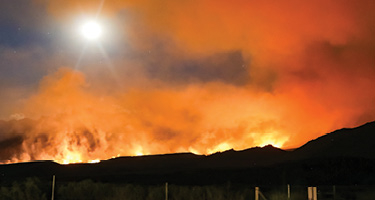But with global warming, a shrinking groundwater supply, and the consequences of the Flint, Michigan, drinking water disaster, that’s all changed—perhaps forever.
Maybe unsurprisingly, California will take the lead in adapting to the new reality. It was the first state settled in the arid West, and other western states generally formed their water policies anticipating heading off the mass evacuation of their water to the Golden State. Two years ago, reacting to the continuing drought, the state legislature passed the Sustainable Groundwater Management Act, which required localities in California to stop depleting local aquifers by balancing water pumped out with water coming in.
The U.S. Environmental Protection Agency and the Senate Finance Committee have estimated that just maintaining a minimal American water infrastructure during the next two decades will require about a $500 billion investment—and doing the bare minimum has become almost reckless in the wake of the Flint disaster. Given the ever-tighter state of government funding in this era, closing that gap will require some innovative thinking, including determining how the private sector can be better incentivized to participate in solutions.
But there’s no magic bullet, according to those who work in the field. “Desalination is one of the things that has to be in a portfolio to maintain the water supply, along with water recycling, storm water recapture, conservation, and a real focus on more efficient water use, both in urban areas and for agriculture. It’s going to take all those things,” says Eric Garner, managing partner of Los Angeles-based Best Best & Krieger, who has practiced water law for more than 25 years.
Some water specialists see an important role for the private sector. While water policy has largely been a creature of the states, and no doubt will continue to be, Wes Miliband of Stoel Rives is hopeful on one front. “No, we don’t have an overall federal water policy. But there are drought bills in every session of Congress, and there is a financial component to them. What I think has to happen to bridge the gap and help the public sector get water projects done together with the private sector is allowing a return on investment, so it’s not all on the public sector anymore. I think some kind of tax incentive or credit is the best way to get it done and that would have to come at the federal level.”
"You might say that water is in certain respects becoming the new oil."
The Poseidon water desalination plant near San Diego, which came online late last year, has also been a source of optimism for those who see converting saltwater to fresh drinking water as one important arrow in the water innovation quiver. Under consideration for at least a generation and more than a decade in development, water plants require at least a dozen government permits. The facility has the capacity to provide 50 million gallons a day, or at least 8 percent of the region’s water needs.
Eric Garner notes that the economics of desalination are more difficult for inland areas because of the cost of pumping it uphill. “It has some limitations, but it has a role to play.” Adds Wes Miliband: “Even though water from this project is priced at $2,200 an acre, which is pretty steep, it’s providing that certainty of availability, versus the volatility we’ve had. Then, the willingness to pay that premium increases.” Plus, it’s local water, which is better for the environment, he adds.
But relentless global warming is making everything tougher. Not only is a warming planet causing higher evaporation rates, but warmer temperatures are causing more water to be consumed. “One, there’s less precipitation. And if it’s warmer, people will use more water for irrigation and other purposes,” says Garner. “Our water systems were built primarily between the 1920s and the 1970s. They were sized based on the hydrologic pattern of that time, meaning for the snow pack to hold till the summer. But when it melts sooner, we have no place to hold that water, so it just goes into the ocean. So there’s a lot of concern about climate change and different weather patterns, and having to adapt.”
A half century ago—buoyed by a strong economy and a federal government that thought big enough to put a man on the moon and to cover the nation in a ribbon of interstate highways—the U.S. Bureau of Reclamation drew up preliminary plans for a nationwide system for moving water where it’s needed. It never got built, and now cost constraints and environmental laws wouldn’t allow it anyway.
Other rich nations are hungrily casting their eyes on American water supplies. The largest dairy company in oil-rich but water-poor Saudi Arabia, for instance, has purchased thousands of acres of farmland in California and Arizona. The reason: To feed its dairy cows, it needs alfalfa, which requires lots of water to cultivate—water the country cannot secure at home. But Wes Miliband doesn’t see such transactions becoming common. “I don’t really envision that China and other countries are going to be lining up to buy up agricultural land in the U.S.”
Nevertheless, you might say that water is in certain respects becoming the new oil, a finite strategic resource that’s becoming a point of conflict across the globe. “I was at an international legal conference in Vienna last year, and people in the mountains of Austria complain that Vienna steals their water,” says Eric Garner. “It’s the same everywhere.”
































